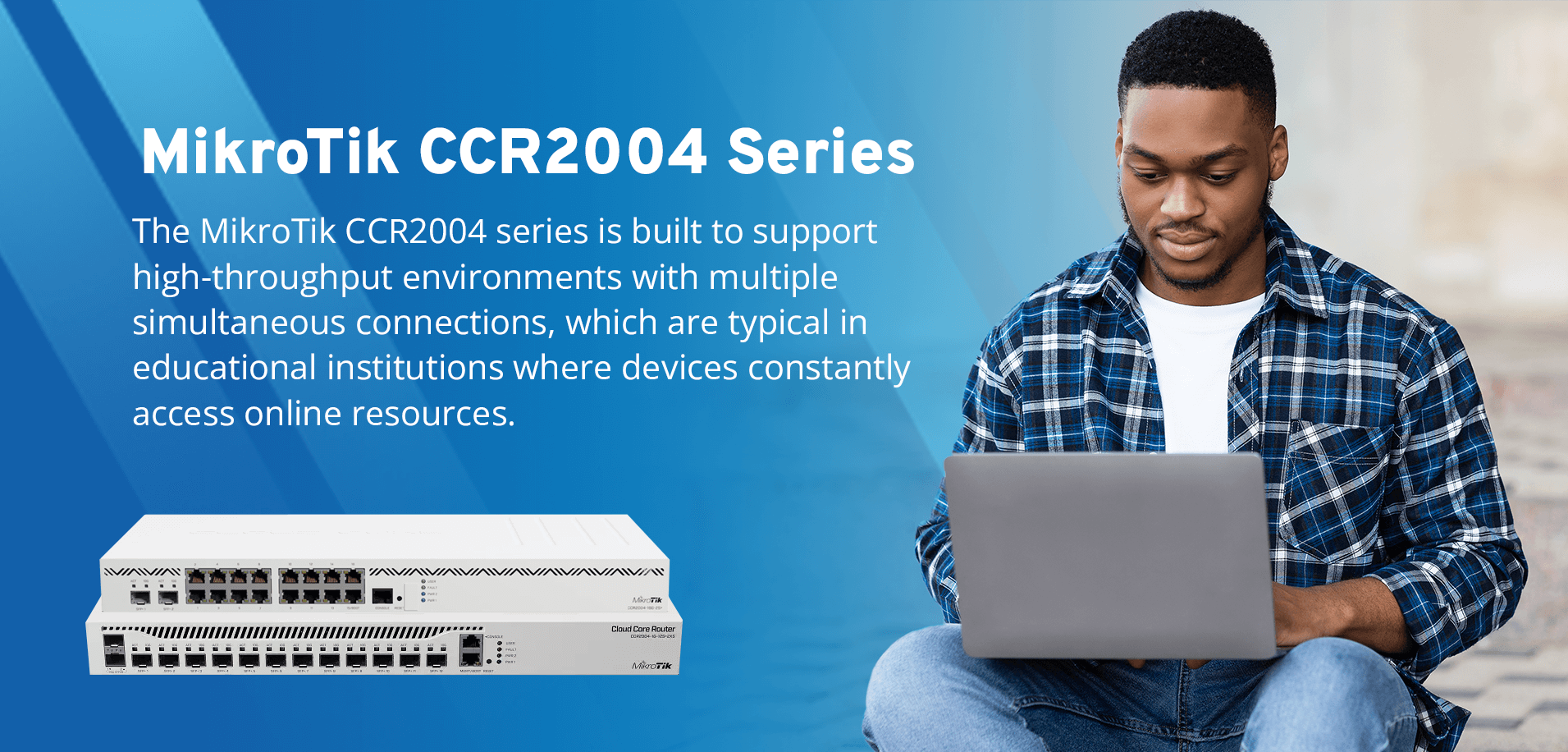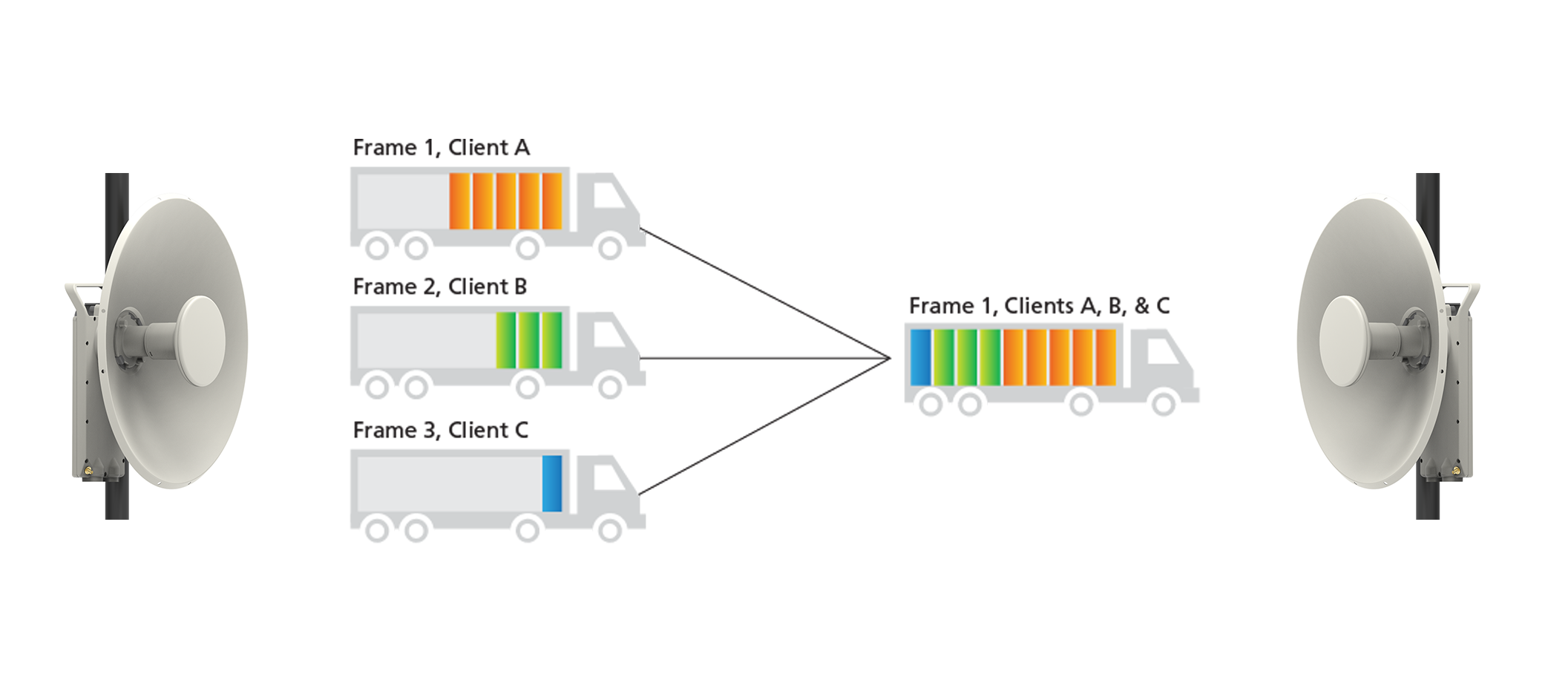
By Dominic Sakwa, Technical Sales Expert
In order to accommodate online materials, digital learning environments, and the increasing number of connected devices in classrooms, modern education mostly relies on strong network infrastructure. To satisfy these needs, the MikroTik CCR2004 series provides a high-performance, reasonably priced solution that enables dependable and scalable network administration. This article explores the architecture, deployment techniques, and performance benefits of the CCR2004 series in order to show how it meets the technical needs of educational institutions such as colleges and universities.
Technical Architecture of the MikroTik CCR2004 Series
Each model in the CCR2004 series — particularly the CCR2004-1G-12S+2XS and CCR2004-16G-2S+ — is engineered to handle the high bandwidth and low-latency needs typical of educational institutions. Here’s an in-depth look at the technical components that make these routers ideal for such settings:
1. Processor and Memory
The CCR2004 series is powered by the Annapurna Labs AL32400 1.7 GHz quad-core Cortex-A57 processor, a 64-bit ARM processor optimized for high-speed data processing. This processing power is essential for handling complex network configurations, such as advanced firewall settings, routing protocols, and VPNs, without compromising performance.
Each model includes 4GB of DDR4 RAM. This ample memory supports smooth performance for intensive routing tasks and real-time monitoring, ensuring the router can handle large numbers of concurrent connections typical in high-density environments like schools and universities.
2. High-Throughput Ports
CCR2004-1G-12S+2XS: This model is equipped with 12 x 10G SFP+ ports and 2 x 25G QSFP+ ports. The SFP+ ports can accommodate multiple 10G fiber connections for campus backbones, while the QSFP+ ports support 25G uplinks for connecting to data centers or high-capacity distribution switches.
CCR2004-16G-2S+: This model, with 16 x 1G Ethernet ports and 2 x 10G SFP+ ports, is ideal for locations requiring more Ethernet connections, such as classroom hubs or dormitory networks, while still benefiting from 10G fiber uplinks.
These port configurations provide flexibility in designing network architectures that accommodate both fiber and Ethernet connections, making it easier to implement campus-wide connectivity across multiple buildings.
3. Dual Power Supply
Redundant power supply capabilities on the MikroTik CCR2004 series help prevent downtime, which is crucial for institutions that rely on continuous connectivity for digital learning and administrative tasks. This feature provides resilience, enabling the router to remain operational even during power fluctuations or if one power source fails.
4. Storage and OS
Each device in the CCR2004 series includes 128 MB of NAND storage. While modest, this capacity is optimized for running RouterOS with Level 6 licensing, providing advanced network features. RouterOS supports numerous routing protocols, such as BGP, OSPF, and MPLS, and offers firewall, VPN, and bandwidth management features essential for educational networks.

Performance and Traffic Management
The MikroTik CCR2004 series is built to support high-throughput environments with multiple simultaneous connections, which are typical in educational institutions where devices constantly access online resources. Here’s how the CCR2004 handles these requirements:
- Packet Forwarding Capacity: The high processing capability and optimized architecture allow the CCR2004 series to process up to 200 Gbps of aggregate throughput (for the CCR2004-1G-12S+2XS), ensuring minimal latency even during peak usage times.
- Firewall and Filtering: MikroTik RouterOS enables robust firewall rules that can filter traffic based on IP addresses, content types, and usage patterns. In a school setting, this allows IT administrators to block certain content categories (e.g., adult content or social media during school hours) and prevent malware or unauthorized devices from accessing the network.
- Bandwidth Management and Prioritization:
- Queue Management: RouterOS includes advanced queue management, allowing for the prioritization of certain traffic types. For example, bandwidth for e-learning platforms, video calls, or online exams can be given priority over general browsing or entertainment streaming.
- Dynamic Bandwidth Allocation: With RouterOS, administrators can dynamically allocate bandwidth to different user groups or departments. This ensures that critical areas, such as online classrooms and administrative offices, maintain stable connectivity even under high network load.

Deployment Strategies for Educational Institutions
1. Core Router in Campus Network Design
- The CCR2004-1G-12S+2XS can be deployed as a core router connecting multiple buildings across a campus using 10G or 25G fiber links. With SFP+ and QSFP+ ports, it can handle high-speed connections from distribution switches in different buildings, centralizing traffic management and ensuring efficient routing between departments and dormitories.
2. Traffic Segmentation via VLANs
- MikroTik RouterOS supports VLANs, allowing network segmentation for different user groups (e.g., students, faculty, and guests). VLANs enhance security by isolating student traffic from sensitive administrative data and enable tailored bandwidth policies for each group.
3. Secure Remote Access for Faculty and Staff
- VPN support on the CCR2004 allows secure, encrypted connections for faculty and staff who may need to access the campus network remotely. RouterOS supports IPsec, OpenVPN, and L2TP protocols, enabling administrators to configure secure access without compromising network integrity.
4. High-Density WiFi Support
- Educational institutions often have high-density WiFi areas, such as auditoriums and libraries. By placing a CCR2004 router at the edge of these high-traffic zones, schools can manage traffic more effectively, providing stability for the multitude of devices accessing the network.
5. Real-Time Monitoring and Alerts
- RouterOS includes monitoring tools like Dude and Syslog integration, allowing network administrators to track performance metrics, monitor network health, and receive alerts in case of anomalies. For example, administrators can be notified of unusual traffic spikes that might indicate a cyber threat or unauthorized access.

MikroTik product news: CCR2004
By implementing a well-designed network with the MikroTik CCR2004 series, schools, universities, and colleges can optimize their digital infrastructure to foster an innovative learning environment. Whether deployed as a core router, a high-density area edge device, or a secure remote access point, the CCR2004 delivers the reliability and scalability essential for future-ready educational networks
Latest Articles
Tue Dec 09 2025
Why MikroTik Should Be in Your 2026 Network PlanMon Oct 13 2025
Netgate pfSense+ Security Gateways: The Security Gateway Built for the Demands of Modern EducationWed Sep 03 2025
hello worldRelated Articles
.jpg)
ePMP 3000 - 5X Performance with Gen3 Technology
-(1).png)
Africa Tech Festival Displays Strides in Connectivity and Telecommunications Infrastructure across Africa

Cambium Networks ePMP Force 425 - The Industry’s First Point-to-Point Solution Based on 802.11ax

The Power of OFDMA in Wireless Broadband
In this article, we delve into the principles of OFDMA, the defining principle of the 802.11ax standard, its applications, and its impact on wireless broadband.

© 2026 PoweredbyOptace Networks Limited. All Rights Reserved.
